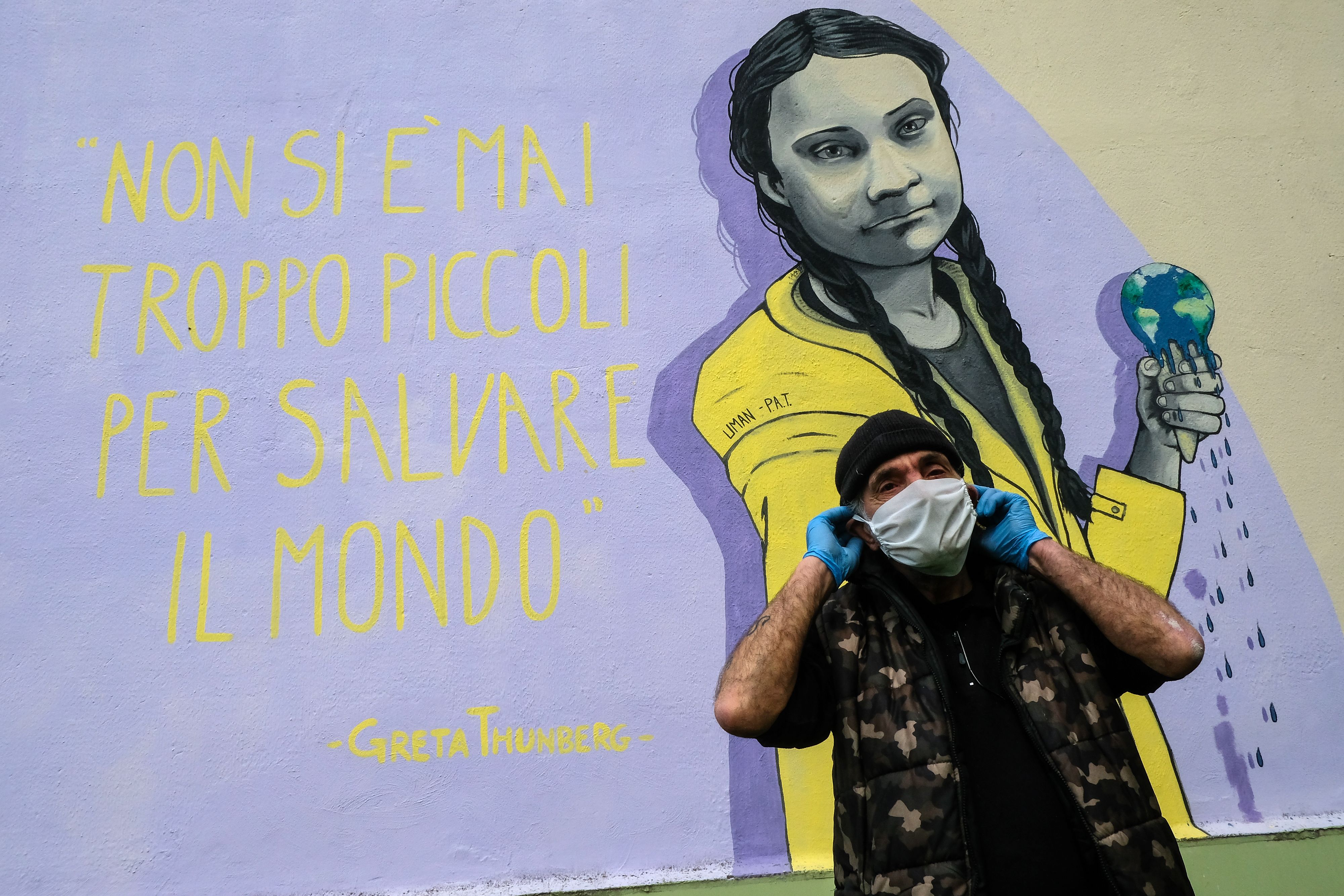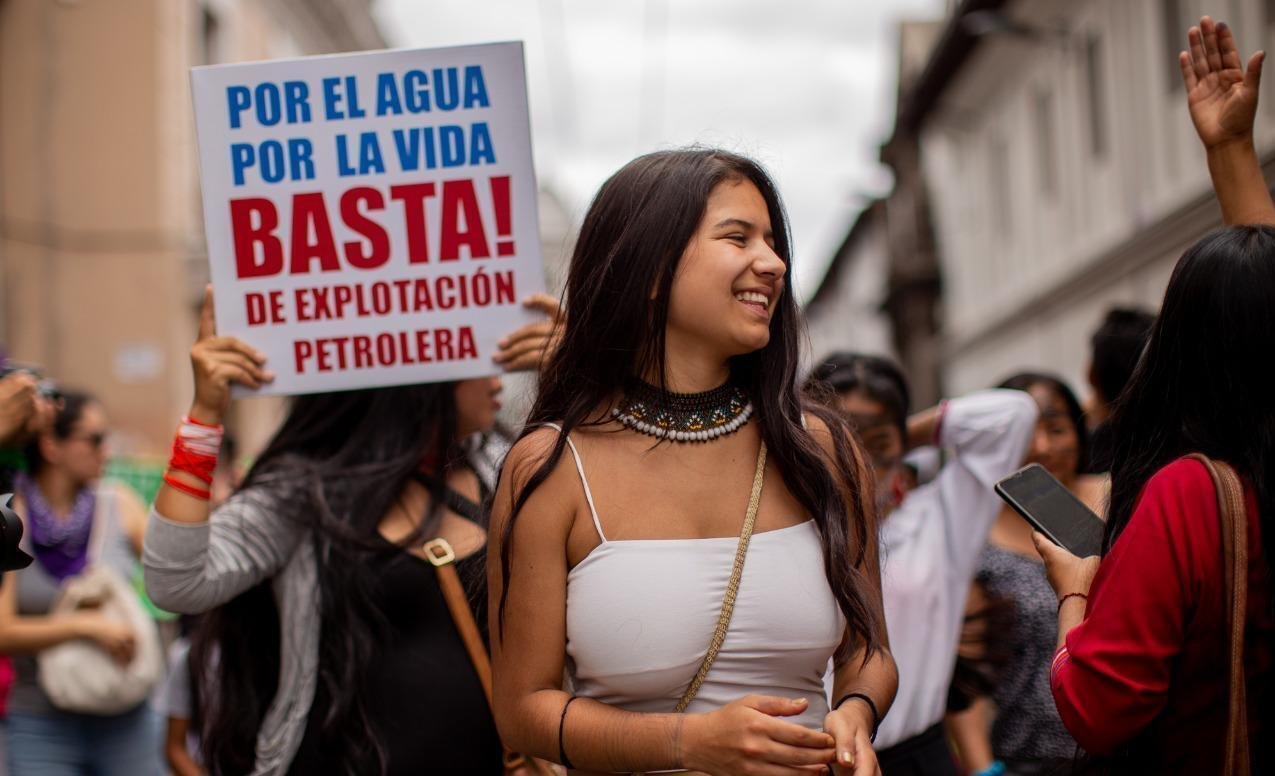Activists are scrambling to deal with the pandemic while trying to make sure no one forgets about global warming.
By Mike Pearl 07 April 2020
This article originally appeared on VICE US.
Normally, Vishal Chauhan, a 30-year-old in London, would be spending his days organizing and protesting for the radical climate direct action movement Extinction Rebellion (XR), famous for its public spectacles—things like shutting down major streets and blasting the UK Treasury with a fake blood firehose. “I’m in Extinction Rebellion because I think we need a regenerative culture. We need a culture which helps human beings achieve our potential as connected, compassionate, kind beings,” he told me.
But thanks to COVID-19, Chauhan is stuck in his flat in Tottenham, one of the poorest areas of London. Like other climate activists around the world, he's suddenly limited in what he can do for the cause. In some ways, he says, the pandemic is “a blessing in disguise.” He’s used to people saying XR wants to change things too much, or too quickly. “What we're seeing here with the COVID health crisis is how quickly we can transform any part of the way in which we live our lives when we see the threat coming,” he said.
But Chauhan knows all too well how grave the threat of this virus is, because he’s a doctor who used to work in an Accident & Emergency (A&E) department, the British equivalent of an ER. About a year ago, in response to the climate crisis, he bailed on practicing medicine to dedicate himself to activism full-time. In response to this fresh crisis, he is now trying to return to his old job. “I’m starting to get my study books out to go back because…” he told me, pausing, seemingly in search of an explanation, but no explanation seemed necessary. “Yeah, I gotta go back,” he said.
The pandemic has brought the entire world economy to a screeching halt, as states and cities have instituted unprecedented lockdown orders. It's also presented a challenge for activists like Chauhan, who felt that they were finally making progress in the fight against climate change. Just as they were getting the world's attention, they have once again lost it. The question is, can they get it back when this is all over?
“Clearly, like every other human enterprise, the climate movement has had to slow and adjust to the virus,” veteran climate activist Bill McKibben said. “There was a ton of momentum, especially in the fight against financial institutions, and some of that has been lost.” Over the past few years, the European Investment Bank has announced an end to loans for oil company projects, and New York City and oil-rich Norway have divested from fossil fuel investments. Recently, investors in Barclay’s Bank—a huge investor in European fossil fuel projects—began pushing the company to follow suit, and activists are demanding that BlackRock, the world's largest asset management company, cut back on fossil fuel investments.
Before the pandemic, there was evidence of a new public focus on climate change. In the early days of the Trump administration, sometime between the publication of David Wallace-Wells’ heart-stopping, viral New York Magazine article “The Uninhabitable Earth” and the IPCC’s pessimistic 2018 report on the vanishing likelihood of our species meeting the targets necessary to keep global warming below 1.5 degrees, something seemed to snap in people’s brains. In 2019 the urgency of acting on climate change truly broke through the noise and became the media phenomenon activists had long hoped it would become. Much of humanity responded to the flurry of haunting news stories and scientific reports with despair, but some were moved to thundering rage. It may not have been enough, but it was, at long last, progress.
Margaret Klein Salamon, co-founder of the organization The Climate Mobilization and one of the leaders of the high-profile movement to persuade political leaders to declare climate emergencies, has a book coming out called Facing the Climate Emergency: How to Transform Yourself,and it has an auspicious release date: the day before the 50th anniversary of Earth Day. That April 22 event is now likely to be muted. “The plans going into [Earth Day] were absolutely huge: three days of huge strikes led by youth. I was so excited. I think this was going to be the biggest moment for the climate emergency movement,” she told me. “Instead, it's all going to be virtual. It's going to be a livestream.”
What can the climate movement really accomplish from home? And when this is all over, will it be able to return to its full strength?

A MAN STANDS UNDER A GRETA THUNBERG MURAL IN ROME. THE QUOTE READS, "YOU'RE NEVER TOO YOUNG TO SAVE THE WORLD." PHOTO BY ANDREAS SOLARO/AFP VIA GETTY
“We have actually achieved many things,” Greta Thunberg told a small group of fellow activists in a livestreamed video chat in late March. “Maybe not what we wanted, but at least we have done something, and sometimes you just need to allow yourself to be—I dunno, proud? Or something like that.” One of the activists in the group felt it might be helpful to recount past successes, but Thunberg didn’t seem at ease in self-care mode. Her overall message was that in this moment, climate activists need to do what they always do: “Listen to the science.” During this crisis, that means social distancing, while keeping in mind, as she noted toward the beginning of the conversation, “the climate crisis is not going away.”
But much of the movement’s progress in fighting the fossil fuel industry might go away—and soon. According to the Sunrise Movement's political and legislative coordinator Lauren Maunus—who said on the Hill’s morning show-style livestream Rising that the 2020 election was “the last, best chance” for he U.S. to meaningfully fight climate change—the fossil fuel industry and its lobbyists are up their usual tricks. “Employing kind of disaster capitalism, pitting us against each other, using government as a force for bad,” was how she described it.
In the interest of speeding up the return of revenues lost due to the crisis, China’s ministry of the environment has in many cases abandoned inspections of potentially polluting factories. On March 26, the U.S. Environmental Protection Agency announced that it would not enforce any regulations, as long as violations can be connected to the COVID-19 crisis, a decision that followed a massive lobbying effort from oil companies. A similar lobbying effort aimed at restoring the reputation of petroleum-based single-use plastic bags appears to be working. A federal bailout for U.S. fossil fuel companies hasn’t materialized but one is thought to be likely.
Perhaps the most vivid example of all is the effort in Canada to jumpstart construction of the Keystone XL pipeline, as announced by Alberta Premier Jason Kenney on March 31. “To make sure it gets done,” Kenney tweeted, “Alberta is putting our money where our mouth is—with a $1.5 billion equity stake, and a $6 billion loan guarantee backstop. Construction begins immediately—starting tomorrow.” The move came two days after restrictions on gatherings of Alberta residents were tightened from 50 people down to 15—a totally understandable safety measure amid the pandemic that will also guarantee that no effective protest can be legally mounted against the new construction project as it charges ahead.
Montana-based indigenous activist Kandi White, the climate campaign coordinator for the Indigenous Environmental Network (IEN), doesn't plan to just sit around while such pipeline projects move forward. “Everyone’s busier now than we were before, because it's almost like our hands are tied,” she said. “The IEN has been fighting the Keystone XL pipeline, and now they're trying to build it, and try to push it through because we're under this mandate to not be out doing activism.” Protesters can’t employ what is self-evidently their most effective strategy—showing up at construction sites and protesting—but, she said “We have been doing webinars, and we have been doing online platform work to get information out to our people.”

EXTINCTION REBELLION MEMBERS IN BERLIN DELIVERING FOOD TO THE NEEDY. PHOTO BY FABIAN SOMMER/PICTURE ALLIANCE VIA GETTY
At the same time, climate activists—who often tend to be more science-focused than the general population—are concerned about telling people about the dangers of COVID-19 and helping out with the more pressing crisis now facing the world.
“I have uncles, cousins, and brothers that work in the [oil] industry, which is also why I know how bad it is—how many spills go unreported, how people are getting sick—and it’s the same with this crisis. Getting the information to the people in a way that they understand, so that they have a trustworthy source, has been very difficult,” White said. It’s a role made all the more difficult, she explained, by the three tribal nationalities sharing land on her reservation—Mandan, Hidatsa, and Arikara. “My sister, and people that I know are still going to work, they're still going to the office. They're still going into the tribal building,” she said. “It's like they're not even taking it as seriously as I feel it should be taken.”
But the ways in which the pandemic dovetails with the climate crisis can also be seen as an advantage, according to McKibben. The similarities, he hopes, will bring the climate crisis to life for people who couldn’t previously wrap their heads around it. “We see what Trump's failure to 'flatten the curve' means for the virus; our failure, 30 years ago, to start flattening the carbon curve leaves us in much the same place," he said. "Now we have to work harder and faster, and there will still be huge damage.”
Until the quarantines are lifted and protesters can once again take to the streets, the climate movement can probably coast on momentum to some degree—scoring up a number of wins and PR victories that were long in the works. A federal judge’s ruling effectively rescinded permits for the Dakota Access pipeline on March 25. Marie Newman, a Sunrise-backed candidate, defeated Illinois Democratic Representative Dan Lipinski, one of Congress's most conservative Democrats, in the state’s primary on March 18. With Earth Day coming, the issue of climate change graces the current covers of Rolling Stone, National Geographic and Fortune magazines, even as the pandemic grips the world.
Moreover, terms like “Green New Deal” have recently transformed into everyday inside-the-beltway vernacular, to the point where President Trump referred to some mild pro-environmental policies in the House bailout bill as “green new deal stuff,” and blamed House Speaker Nancy Pelosi for their inclusion. (Pelosi once dismissively referred to the Green New Deal as “the green dream or whatever they call it.”) Amid a growing chorus of calls for a New Deal-sized public works project to help Americans out of the current economic crisis, this sort of confusion could redound to the benefit of the climate movement.
For Maunus and the rest of the Sunrise Movement, which made a name for itself by protesting inside Pelosi’s office in favor of the Green New Deal in 2018, “this is really a moment of unprecedented opportunity for change.” That doesn’t just mean legislation—projects in the works at Sunrise include “free painting of, Green New Deal signs, motor processions, and six-feet group protests,” Maunus said.
In light of the political and economic instability this crisis has brought to light, some activists would rather just toss out the present governmental and economic systems altogether. “A lot of the old-school anarchist people have been dreaming of this kind of anarcho-federalist model,” Chauhan told me. “Going to small communities, or like having assemblies like the Rojava model, where decision-making is devolved to the most local level possible, and people feel empowered because they're making decisions.”
In fact, he told me his Tottenham flat is meant to be his organizing base of operations, “because I thought if there was gonna be a revolution it would be here. Or maybe not revolution, but social upheaval, disenfranchisement of the poor and minority groups, and so I wanted to be organizing here. Meanwhile a lot of my mates all left. So the house I am in usually has eight people in it, only two people are left ‘cause everyone else went back to smaller towns or the countryside to be safer.”
No large-scale uprising has occurred, to be sure, but according to Chauhan, wherever local activists in the UK have begun operating in earnest, XR members—known internally as rebels—are participating as needed, a part of the organizational theory of mutual aid. “In the UK, 3,500 local mutual aidgroups have been set up in the space of three weeks. Fucking amazing! Huge! Nothing to do with XR, but a lot of XR rebels are doing it.” The purpose, he said, is simply, “planting the seeds in those spaces, or making the right interventions.”
Across all the activist organizations I spoke to, the theme of gardening in quarantine appeared again and again. “I’ve been telling folks it's a really good time to get your seeds going and get your gardens going. Spring is coming. My crocuses have bloomed,” White said. “The fact that the whole entire world is waking up to indigenous knowledge now is great, but it's not new. If you go stand on the grass without your socks and shoes on, or if you're in a forest next to a tree, you actually start to feel better.”
“People are so disconnected from these very basic concepts, and that is capitalism,” she continued. “That is colonization—to get your mind off of very basic and true concepts of our relationship with and our connection to the land.”
Mike Pearl is the author of The Day It Finally Happens: Alien Contact, Dinosaur Parks, Immortal Humans—and Other Possible Phenomena. Follow him on Twitter.

























